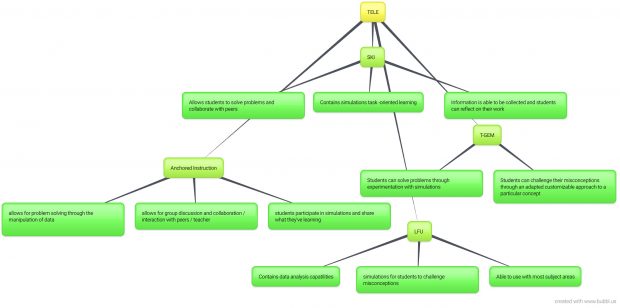TELEs offer a wonderful and engaging environment for students to learn in. In module B, we looked at many educational technologies that each offered a unique learning experience for students depending on the subject area. As knowledge becomes more interconnected through the internet and programs becomes more open source, it is important for educators to embrace new models. Over the past few weeks, we’ve investigated Anchored Instruction, Web Inquiry Science Environments, and Learning for Use and T-GEM which have each had their own affordances for generating comprehensive lessons through a specific pedagogical approach. Through the Jasper Series, students were able to investigate certain topics related to mathematics. However, these problems that they were investigating were rooted in real life situations that they may come across. This allows students to understand the context of the concepts they were learning. In SKI and WISE, teachers were able to set up a learning environment that allowed students to interactively engage with interactive models and content related to many areas of science. Teachers were able to create projects for the students to complete as well as access ones that other teachers had created for free. Existing content could even be modified to suit the needs of any classroom. With Learning for Use, Geographic Information Systems were explored. Students have the opportunity to situate their learning and manipulated different mapping software in their community or country. With GIS you are able to have students create mapping using different projections to bring more meaning to their work. The students are able to learn valuable data collection skills and how to input that data into a mapping program to visual their understanding of a phenomena. The T-GEM framework is evident in the program Chemland. This programs allows students to simulate different interactions between chemicals, metals, and other materials. It also allows for the altering of other variables. The T-GEM framework can be applied to a variety of contexts so that students can enhance their understanding of a concept through various simulations.
What I like about using the WISE program is that students are able to engage in a very structured lesson that scaffolds concepts as they explore various lessons. I like how teachers are able to modify and share their work for other teachers are able to use it. Platforms that embrace the sharing of knowledge seem to be more robust because many experts are able to have a hand in the project. WISE is a great program for an elearning or blended learning program.

Hi Tyler,
I really like the diagram you created. It is elegant in its simplicity. As I evolved as an educator I have really come to appreciate the KISS (keep it simple) principle. I appreciate how you took such diverse concepts and linked them simply and easily. It is very easy to let the sheer amount of information overwhelm the reader by creating elaborate linkages. The flow chart takes the big ideas and connects them and it allows me to look at each TELE in a new way and keep my thinking organized. While I realize that linking concepts is not necessarily so neat and clean your diagram is spot on for my learning. Thanks
By the way, I totally agree with where you put SKI as it is such an important component of learning.
Catherine
Tyler,
Thanks for the excellent flow chart and summary. I liked that having all the key features of all 4 models next to each other really helps when considering which one would be best suited for different lessons, topics, or students. In addition, the layout helps when considering whether features of one model can be adapted to another one to create hybrid teaching models.
Hi Tyler,
Great summary and pictorial summarizing concepts thus far!
I also liked your synopsis of WISE and its capabilities in the classroom of helping improve student learning. Having familiarized myself with the platform, I would definitely use it in my classes where applicable and topics fit. However, prior to this program I hadn’t heard of the platform (and neither have many of my colleagues at my school). I think it’s an interesting juxtaposition that WISE (and other programs/apps) are available to use but many educators aren’t necessarily aware of them nor have the time to look for such aids in the classroom. How has your experience been with awareness of these programs?
Thanks for the post!
Darren